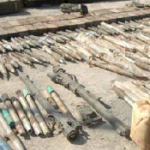Air Force Briefing Shows Nuclear Modernizations But Ignores US and UK Programs
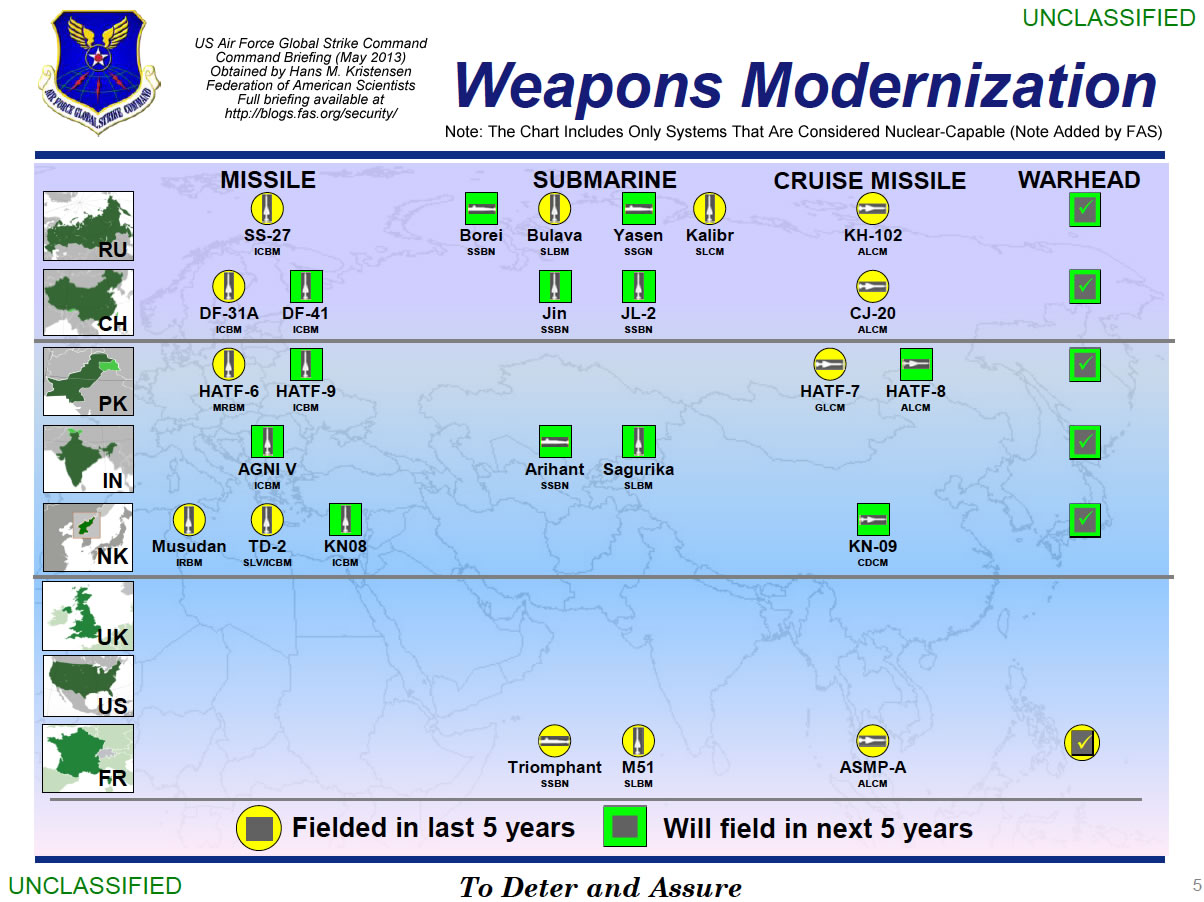
Click to view large version. Full briefing is here.
By Hans M. Kristensen
China and North Korea are developing nuclear-capable cruise missiles, according to U.S. Air Force Global Strike Command (AFGSC).
The new Chinese and North Korean systems appear on a slide in a Command Briefing that shows nuclear modernizations in eight of the world’s nine nuclear weapons states (Israel is not shown).
The Chinese missile is the CJ-20 air-launched cruise missile for delivery by the H-6 bomber. The North Korean missile is the KN-09 coastal-defense cruise missile. These weapons would, if for real, be important additions to the nuclear arsenals in Asia.
At the same time, a closer look at the characterization used for nuclear modernizations in the various countries shows generalizations, inconsistencies and mistakes that raise questions about the quality of the intelligence used for the briefing.
Moreover, the omission from the slide of any U.S. and British modernizations is highly misleading and glosses over past, current, and planned modernizations in those countries.
For some, the briefing is a sales pitch to get Congress to fund new U.S. nuclear weapons.
Overall, however, the rampant nuclear modernizations shown on the slide underscore the urgent need for the international community to increase its pressure on the nuclear weapon states to curtail their nuclear programs. And it calls upon the Obama administration to reenergize its efforts to reduce the numbers and role of nuclear weapons.
Russia
![]()
The briefing lists seven Russian nuclear modernizations, all of which are well known and have been underway for many years. Fielded systems include SS-27 ICBM, Bulava SLBM, Kalibr SLCM, and KH-102 ALCM.
It is puzzling, however, that the briefing lists Bulava SLBM and Kalibr SLCM as fielded when their platforms (Borei SSBN and Yasen SSGN, respectively) are not. The first Borei SSBN officially entered service in January 2013.
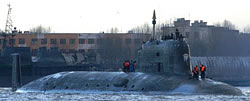
Nuclear Cruise Missile For Yasen SSGN
It is the first time I’ve seen a U.S. government publication stating that the non-strategic Kalibr land-attack SLCM is nuclear (in public the Kalibr is sometimes called Caliber). The first Yasen SSGN, the Severodvinsk, test launched the Kalibr in November 2012. The weapon will also be deployed on the Akula-class SSGN. The Kalibr SLCM, which is dual-capable, will probably replace the aging SS-N-21, which is not. There are no other Russian non-strategic nuclear systems listed in the AFGSC briefing.
A new warhead is expected within the next five years, but since no new missile is listed the warhead must be for one of the existing weapons.
China
![]()
The briefing lists six Chinese nuclear modernizations: DF-31A ICBM, DF-41 ICBM, Jin SSBN, JL-2 SLBM, CJ-20 ALCM, and a new warhead.
The biggest surprise is the CJ-20 ALCM, which is the first time I have ever seen an official U.S. publication crediting a Chinese air-launched cruise missile with nuclear capability. The latest annual DOD report on Chinese military modernization does not do so.
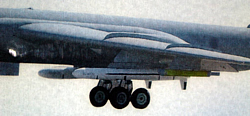
H-6 with CJ-20. Credit: Chinese Internet.
The CJ-20 is thought to be an air-launched version of the 1,500+ kilometer ground-launched CJ-10 (DH-10), which the Air Force in 2009 reported as “conventional or nuclear” (the AFGSC briefing does not list the CJ-10). The CJ-20 apparently is being developed for delivery by a modified version of the H-6 medium-range bomber (H-6K and/or H-6M) with increased range. DOD asserts that the H-6 using the CJ-20 ALCM in a land-attack mission would be able to target facilities all over Asia and Russia (east of the Urals) as well as Guam – that is, if it can slip through air defenses.
The elusive DF-41 ICBM is mentioned by name as expected within the next five years. References to a missile known as DF-41 has been seen on and off for the past two decades, but disappeared when the DF-31A appeared instead. The latest DOD report does not mention the DF-41 but states that, “China may also be developing a new road-mobile ICBM, possibly capable of carrying a multiple independently targetable reentry vehicle (MIRV).” (Emphasis added).
AFGSC also predicts that China will field a new nuclear warhead within the next five years. MIRV would probably require a new and smaller warhead but it could potentially also refer to the payload for the JL-2.
Pakistan
![]()
Pakistan is listed with five nuclear modernizations, all of which are well known: Hatf-8 (Shaheen II) MRBM, Hatf-9 (NASR) SRBM, Hatf-7 (Babur) GLCM, Hatf-8 (Ra’ad) ALCM, and a new warhead. Two of them (Hatf-8 and Hatf-7) are listed as fielded.
The briefing mistakenly identifies the Hatf-9 as an ICBM instead of what it actually is: a short-range (60 km) ballistic missile.
The new warhead might be for the Hatf-9.
India
![]()
India is listed with four nuclear modernizations, all of which are well known: Agni V ICBM, Arihant SSBN, “Sagurika” SLBM, and a new warhead. The U.S. Intelligence Community normally refers to “Sagurika” as Sagarika, which is known as K-15 in India.
Neither the Agni III nor Agni IV are listed in the briefing, which might indicate, if correct, that the two systems, both of which were test launched in 2012, are in fact technology development programs intended to develop the technology to field the Agni V.
The U.S. Intelligence Community asserts that the Agni V will be capable of carrying multiple warheads, as recently stated by an India defense industry official – a dangerous development that could well motivate China to deploy multiple warheads on some of its missiles and trigger a new round of nuclear competition between India and China.
The new warhead might be for the SLBM and/or for Agni V.
North Korea
![]()
North Korea is listed with five nuclear modernizations: Musudan IRBM, TD-2 SLV/ICBM, KN-08 ICBM, KN-09 CDCM, and a warhead.

The biggest surprise is that AFGSC asserts that the KN-09 is nuclear-capable. There are few public reports about this weapon, but the South Korean television station MBC reported in April that it has a range of 100-120 km. MBC showed KN-09 as a ballistic missile, but AFGSC lists it as a CDCM (Coastal Defense Cruise Missile).
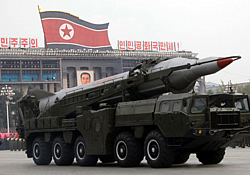
The Musudan IRBM is listed as “fielded” even though the missile, according to the U.S. Intelligence Community, has never been flight tested. In this case, “fielded” apparently means it has appeared but not that it is operational or necessarily deployed with the armed forces.
The Mushudan is listed as “fielded,” similar to the Russian SS-27, even though the North Korean missile has never been flight tested.
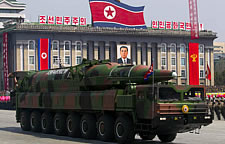
The KN-08 ICBM, which was displayed at the May 2012 parade, was widely seen by non-governmental analysts to be a mockup. But AFGSC obviously believes the weapon is real and expected to be “fielded” within the next five years. There were rumors in January 2013 that North Korea had started moving KN-08 launchers around the country at the beginning of a saber-rattling campaign that lasted through March.
Finally, the AFGSC briefing also predicts that North Korea will field a nuclear warhead within the next five year. Whether this refers to North Korea’s first weaponized warhead or newer types is unclear.
United Kingdom
![]()
The UK section does not include any weapons modernizations, which doesn’t quite capture what’s going on. For example, Britain is deploying the modified W76-1/Mk4A, which British officials have stated will increase the targeting capability of the Trident II D5 SLBM. Accordingly, a warhead icon has been added to the U.K. bar above.
Moreover, although the final approval has not been given yet, Britain is planning construction of a new SSBN to replace the current fleet of four Vanguard-class SSBNs. The missile section is under development in the United States. The new submarine will also receive the life-extended D5 SLBM.
United States
![]()
The U.S. section also does not show any nuclear modernizations, which glosses over important upgrades.
For example, the Minuteman III ICBM is in the final phases of a decade-long multi-billion dollar life-extension program that will extend the weapon to 2030. Privately, Air Force officials are joking that everything except the shell is new. Accordingly, a fielded ICBM icon has been added to the U.S. bar.
Moreover, full-scale production and deployment of the W76-1/Mk4A warhead on the Trident II D5 SLBM is underway. The combination of the new reentry body with the D5 increases the targeting capability of the weapon. Accordingly, a fielded warhead icon has been added to the U.S. bar.
In addition, from 2017 the U.S. Navy will begin deploying a modified life-extended version of the D5 SLBM (D5LE) on Ohio-class SSBNs. Production of the D5LE is currently underway, which will be “more accurate” and “provide flexibility to support new missions,” according to the navy and contractor. Accordingly, a forthcoming SLBM icon has been added to the U.S. bar.
Finally, the United States has begun design of a new SSBN class, a long-range bomber, a long-range cruise missile, a fighter-bomber, a guided standoff gravity bomb, and is studying a replacement-ICBM.
Hardly the dormant nuclear enterprise portrayed in the briefing.
France
![]()
France is listed with four nuclear modernizations, all well known: Triomphant SSBN, M51 SLBM, ASMP-A ALCM, and a new warhead.
The introduction of the ASMP-A is complete but the M51 SLBM is still replacing M45 SLBMs on the SSBN fleet.
The warhead section only appears to include the TNA warhead for the ASMP-A but ignores that France from 2015 will begin replacing the TN75 warhead on the M51 SLBM with the new TNO.
What is Meant by Nuclear and Fielded?
The AFGSC briefing is unclear and somewhat confusing about what constitutes a nuclear-capable weapon system and when it is considered “fielded.”
AFGSC confirmed to me that the slide only lists nuclear-capable weapon systems.
Air Force regulations are pretty specific about what constitutes a nuclear-capable unit. According to Air Force Instruction 13-503 regarding the Nuclear-Capable Unit Certification, Decertification and Restriction Program, a nuclear-capable unit is “a unit or an activity assigned responsibilities for employing, assembling, maintaining, transporting or storing war reserve (WR) nuclear weapons, their associated components and ancillary equipment.”
This is pretty straightforward when it comes to Russian weapons but much more dubious when describing North Korean systems. Russia is known to have developed miniaturized warheads and repeatedly test-flown them on missiles that are operationally deployed with the armed forces.
North Korea is a different matter. It is known to have detonated three nuclear test devices and test-launched some missiles, but that’s pretty much the extent of it. Despite its efforts and some worrisome progress, there is no public evidence that it has yet turned the nuclear devices into miniaturized warheads that are capable of being employed successfully by its ballistic or cruise missiles. Nor is there any public evidence that nuclear-armed missiles are operationally deployed with the armed forces.
Moreover, the U.S. Intelligence Community has recently issued strong statements that cast doubt on whether North Korea has yet mastered the technology to equip missile with nuclear warheads. James Clapper, the director of National Intelligence, testified before the Senate on April 18, 2013, that despite its efforts, “North Korea has not, however, fully developed, tested, or demonstrated the full range of capabilities necessary for a nuclear-armed missile.”
So how can the AFGSC briefing label North Korean ballistic missiles as nuclear-capable – and also conclude that the KN-09 cruise missile is nuclear-capable?
There are similar questions about the determination of when a weapon system is “fielded.” Does it mean it is fielded with the armed forces or simply that it has been seen? For example, how can a North Korean Musudan IRBM be considered fielded similarly to a Russia SS-27 ICBM?
Or how can the Musudan IRBM be identified as already “fielded” when it has not been flight tested and only displayed on parade, when the KN-08 is identified as not “fielded” even though it has also not been flight tested, also been displayed on parade, and even moved around North Korea?
Finally, how can the Russian Bulava SLBM and Kalibr SLCM be listed as “fielded” when their delivery platforms (Borei SSBN and Yasen SSGN, respectively) are listed as not fielded?
These inconsistencies cast doubt on the quality of the AFGSC briefing and whether it represents the conclusion of a coordinated Intelligence Community assessment, or simply is an effort to raise money in Congress for modernizing U.S. bombers and ICBMs.
Implications and Recommendations
There are still more than 17,000 nuclear weapons in the world and all the nuclear weapon states are busy maintaining and modernizing their arsenals. After Russia and the United States have insisted for decades that nuclear cruise missiles are essential for their security, the AFGSC briefing claims that China and North Korea are now trying to follow their lead.
For some, the AFGSC briefing will be (and probably already is) used to argue that nuclear threats against the United States and its allies are increasing and that Congress therefore should oppose further reductions of U.S. nuclear forces and instead approve modernizations of the remaining arsenal.
But Russia is not expanding its nuclear forces, the nuclear arsenals of China and Pakistan are much smaller than U.S. forces, and North Korea is in its infancy as a nuclear weapon state.
Instead, the rampant nuclear modernizations shown in the briefing symbolize struggling arms control and non-proliferation regimes that appear inadequate to turn the tide. They are being undercut by recommitments of a small group of nuclear weapon states to retain and improve nuclear forces for the indefinite future. The modernizations are partially being sustained by non-nuclear weapon states – often the very same who otherwise say they want nuclear disarmament – that insist on being protected by nuclear weapons.
The AFGSC briefing shows that there’s an urgent need for the international community to increase its pressure on the nuclear weapon states to curtail their nuclear programs. Especially limitations on MIRVed missiles are urgently needed. For its part, the Obama administration must reenergize its efforts to reduce the numbers and role of nuclear weapons.
There have been many nice speeches about reducing nuclear arsenals but too little progress on limiting the endless cycle of modernizations that sustain them.
Document: Air Force Global Strike Command Command Briefing
This publication was made possible by grants from the New-Land Foundation and Ploughshares Fund. The statements made and views expressed are solely the responsibility of the author.
Regulating Japanese Nuclear Power in the Wake of the Fukushima Daiichi Accident
The 2011 accident at the Fukushima Daiichi nuclear power plant was preventable. The Great East Japan earthquake and the tsunami that followed it were unprecedented events in recent history, but they were not altogether unforeseeable. Stronger regulation across the nuclear power industry could have prevented many of the worst outcomes at Fukushima Daiichi and will be needed to prevent future accidents.
In an FAS issue brief, Dr. Charles Ferguson and Mr. Mark Jansson review some of the major problems leading up to the accident and provides an overview of proposed regulatory reforms, including an overhaul of the nuclear regulatory bureaucracy and specific safety requirements which are being considered for implementation in all nuclear power plants.
Better Understanding North Korea: Q&A with Seven East Asian Experts, Part 2
 Editor’s Note: This is the second of two postings of a Q&A conducted primarily by the Federation of American Scientists regarding the current situation on the Korean Peninsula. Developed and edited by Charles P. Blair, Mark Jansson, and Devin H. Ellis, the authors’ responses have not been edited; all views expressed by these subject-matter experts are their own. Please note that additional terms are used to refer to North Korea and South Korea, i.e., the DPRK and ROK respectively.
Editor’s Note: This is the second of two postings of a Q&A conducted primarily by the Federation of American Scientists regarding the current situation on the Korean Peninsula. Developed and edited by Charles P. Blair, Mark Jansson, and Devin H. Ellis, the authors’ responses have not been edited; all views expressed by these subject-matter experts are their own. Please note that additional terms are used to refer to North Korea and South Korea, i.e., the DPRK and ROK respectively.
Researchers from the Federation of American Scientists (FAS) asked seven individuals who are experts in East Asia about the the recent escalation in tensions on the Korean Peninsula. Is North Korea’s recent success with its nuclear test and satellite launch evidence that it is maturing? Is there trepidation in Japan over the perceived threat of North Korea attacking Japan with a nuclear weapon? Has North Korea mastered re-entry vehicle (RV) technology? Is there any plausible way to de-nuclearize North Korea?
This is the second part of the Q&A, featuring Dr. Yousaf Butt, Dr. Jacques Hymans and Ms. Masako Toki. Read the first part here. (more…)
Better Understanding North Korea: Q&A with Seven East Asian Experts, Part 1
 Editor’s Note: This is the first of two postings of a Q&A conducted primarily by the Federation of American Scientists regarding the current situation on the Korean Peninsula. Developed and edited by Charles P. Blair, Mark Jansson, and Devin H. Ellis, the authors’ responses have not been edited; all views expressed by these subject-matter experts are their own. Please note that additional terms are used to refer to North Korea and South Korea, i.e., the DPRK and ROK respectively.
Editor’s Note: This is the first of two postings of a Q&A conducted primarily by the Federation of American Scientists regarding the current situation on the Korean Peninsula. Developed and edited by Charles P. Blair, Mark Jansson, and Devin H. Ellis, the authors’ responses have not been edited; all views expressed by these subject-matter experts are their own. Please note that additional terms are used to refer to North Korea and South Korea, i.e., the DPRK and ROK respectively.
Researchers from the Federation of American Scientists (FAS) asked seven individuals who are experts in East Asia about the the recent escalation in tensions on the Korean Peninsula. Is North Korea serious about their threats and are we on the brink of war? What influence does China exert over DPRK, and what influence is China wiling to exert over the DPRK? How does the increase in tension affect South Korean President Park Guen-he’s political agenda?
This is the first part of the Q&A featuring Dr. Ted Galen Carpenter, Dr. Balbina Hwang, Ms. Duyeon Kim and Dr. Leon Sigal. Read part two here.
Sanctions and Nonproliferation in North Korea and Iran
The nuclear programs of North Korea and Iran have been, for many years, two of the most pressing and intractable security challenges facing the United States and the international community. While frequently lumped together as “rogue states,” the two countries have vastly different social, economic, and political systems, and the history and status of their nuclear and long-range missile programs differ in several critical aspects.
The international responses to Iranian and North Korean proliferation bear many similarities, particularly in the use of economic sanctions as a central tool of policy. Daniel Wertz, Program Officer at the National Committee on North Korea, and Dr. Ali Vaez, former Director of the Iran Project at the Federation of American Scientists, offer a comparative analysis of U.S. policy toward Iran and North Korea in a FAS issue.
When the Boomers Went to South Korea
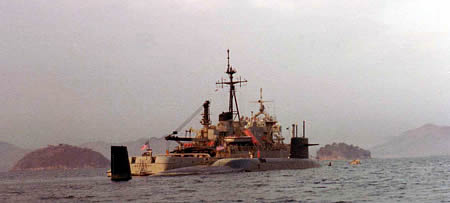
There are not many public pictures showing the U.S. ballistic missile submarine visits to South Korea. This one apparently shows the USS John Marshall (SSBN-611) in Chinhae in 1979. The submarine carried 16 Polaris A3 missiles with a total of 48 200-kt warheads.
.
Back in the late-1970s, U.S. nuclear-armed ballistic missile submarines suddenly started conducting port visits to South Korea. For a few years the boomers arrived at a steady rate, almost every month, sometimes 2-3 visits per month. Then, in 1981, the visits stopped and the boomers haven’t been back since.
At the time the visits began, the United States also had several hundred nuclear weapons deployed on land in South Korea, but the submarine visits apparently were needed to further demonstrate that the United States was prepared to defend the south against an attack from the north.
After North Korea’s nuclear tests in 2006 and 2009, shelling of South Korean territory and the sinking of one of its warships, there have been reports recently that an increasing number of South Koreans want the United States to deploy nuclear weapons in South Korea again, after the last such weapons were withdrawn in 1991. They think it is necessary to deter North Korea.
Some analysts have even suggested that the United States should develop an improved nuclear earth penetrator to better threaten North Korean deeply buried targets, an idea that was previously proposed the Bush administration but rejected by Congress.
Boomers in Chinhae
The SSBN visits to South Korea are unique; the United States normally does not send SSBNs into foreign ports. But there are exceptions. In 1963, the USS Sam Houston (SSBN-609) sailed into Izmir in Turkey on a mission to assure the Turkish government that the United States still had the nuclear capability to defend Turkey even after Jupiter missiles were withdrawn from bases in Turkey following the Cuban missile crisis. The Izmir visit was a one-time event, however, and no SSBN visited foreign ports for the next 12 years.
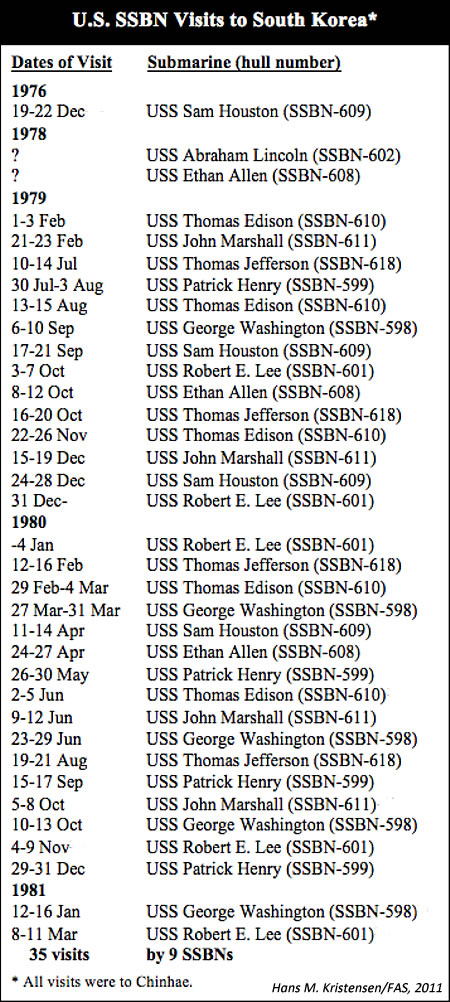 |
| Between December 1976 and March 1981, nine U.S. ballistic missile submarines conducted 35 port visits to South Korea |
Then, on December 19, 1976, the USS Sam Houston suddenly arrived in Chinhae, South Korea. The ship was under order to “surface in Korea for 3 days to ‘rattle the saber,” according to a former crew member. This was the first foreign port visit of a U.S. SSBN in the Pacific.
Two visits followed in 1978 but in 1979 the operations expanded with 14 visits conducted by eight SSBNs. In October that year, three SSBNs made three visits for a combined presence of 15 days.
The following year, in 1980, the number of visits expanded to 15, in June with three visits for a combined 17 days in port. In 1981, coinciding with the phase-out of the Polaris SLBM, the visits dropped to only two.
The Political Context
The 35 port visits conducted by nine SSBNs to Chinhae were a powerful message to South Korea and its potential adversaries about the U.S. nuclear capabilities in the area. But exactly what the reasons for the visits were remain unclear.
The visits took place in a complex political situation. South Korea had started a program to develop nuclear weapons technology, President Carter wanted to withdraw U.S. nuclear weapons from South Korea, and North Korea was building up its military forces backed by China and the Soviet Union.
Ironically, South Korea had started a nuclear weapons technology program in 1974 not because of doubts about the U.S. nuclear umbrella per ce, but because, according to the CIA, of doubts about the reliability of the overall U.S. security commitment. The program reportedly was terminated in 1976 after U.S. and French pressure. [See here for an insightful analysis]
At the same time, newly elected president Jimmy Carter wanted to withdraw U.S. nuclear weapons from bases in South Korea. At the time the SSBN visits began, the U.S. had approximately 500 ground-launched nuclear weapons at bases in South Korea – roughly the same number of warheads as onboard the missiles of the nine visiting SSBNs. [For a brief history of U.S. deployment of nuclear weapons in South Korea, go here]. In the end, Carter’s withdrawal didn’t happen but the land-based weapons were significantly reduced (see below).
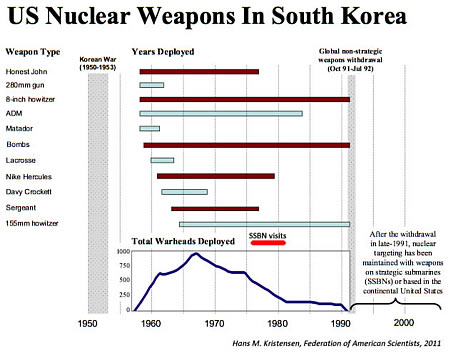 |
| During the time of the SSBN visits, the number of U.S. nuclear weapons deployed in South Korea was reduced from roughly 500 to 150. The last were withdrawn in 1991. |
.
The SSBN visits might also have been designed to remind China about the U.S. military presence in the region, despite its defeat in Vietnam. The end of the SSBN visits to South Korea in 1981 and the phase-out of the Polaris SSBNs fleet in the Pacific coincided with China’s removal from the U.S. strategic war plan as part of the Reagan administration’s efforts to recruit China as a partner against the Soviet Union. (China was later reinstated in the war plan in 1997 by the Clinton administration.)
In September 1982, the first new Ohio-class SSBN deployed on its first patrol in the Pacific and over the next five years it was followed by seven other boats, each loaded with 24 longer-range and more accurate Trident I C-4 missiles. (All have since been upgraded to the even more capable Trident II D-5 missile). None of the Trident SSBNs have ever visited South Korea, even after the withdrawal of the last land-based nuclear weapons from the country in 1991.
Implications
The SSBN visits to South Korea are a curious but little noticed footnote in the Cold War history. More research is needed to better describe exactly why they happened, but the visits seemed intended to signal assurance to South Korea and deterrence to its adversaries.
As such the visits have potential implications for today. North Korea has since crossed the nuclear threshold, support seems to be growing in South Korea for returning U.S. nuclear weapons to the peninsula, and some argue that better nuclear capabilities are needed to deter Pyongyang.
But the visits are a reminder of the already considerable nuclear capabilities in the region that could be used to signal. Nuclear-capable bombers routinely forward deploy to Guam, and the eight SSBNs patrolling in the Pacific could surface again and visit South Korea if necessary.
 |
| Nearly 30,000 U.S. troops in South Korea, large-scale conventional exercises such as the three-carrier battlegroup Valiant Shield (image) and the half-a-million-man Ulchi Freedom Guardian, as well as forward operations of nuclear-capable forces in the region provide a powerful deterrent. |
.
The question is whether it is necessary. The nuclear capabilities the United States operates in the Pacific region today are far more capable than in the 1970s, and the combined conventional forces of South Korea and the United States enjoy a significant advantage over North Korea’s aging conventional forces. To the extent that anything can, these forces should be sufficient to deter large-scale North Korean attacks against the south.
Indeed, Pyongyang’s obsession with the U.S. nuclear capabilities – even its misperception that Washington still deploys nuclear weapons in South Korea – strongly suggests that the current nuclear umbrella has Pyongyang’s full attention and that nuclear redeployment or nuclear bunker busters are not needed. After all, the objective is to move forward toward a denuclearization of the Korean peninsula, not return to the past.
This publication was made possible by a grant from Carnegie Corporation of New York and Ploughshares Fund. The statements made and views expressed are solely the responsibility of the author.
Missile Watch – February 2010
Missile Watch
A publication of the FAS Arms Sales Monitoring Project
Vol. 3, Issue 1
February 2010
Editor: Matt Schroeder
Contributing Author: Matt Buongiorno
Graphics: Alexis Paige
Contents:
Afghanistan: No recent discoveries of shoulder-fired, surface-to-air missiles in insurgent arms caches
Eritrea: UN slaps arms embargo on major missile proliferator
Iraq: Fewer public reports of seized shoulder-fired missiles in Iraq, but MANPADS still a threat
Ireland: Alleged plot to shoot down a police helicopter may have involved surface-to-air missile
Myanmar: 300 shoulder-fired missiles in insurgent arsenal, claims Thai Colonel
North Korea: North Korean arms shipment included MANPADS, Thai report confirms
Peru: Igla missiles stolen from Peruvian military arsenals, claims alleged trafficker
Spain: Failed assassination attempts underscore the risks for terrorists of relying on black market missiles
United States: Congress to receive DHS report on anti-missile systems for commercial airliners in February
United States: Documents from trial of the “Prince of Marbella” reveal little about his access to shoulder-fired missiles
United States: No new international MANPADS sales since 1999
Venezuela: U.S. receives “assurances” from Russia regarding controls on shoulder-fired missiles sold to Venezuela, but questions remain
This issue of Missile Watch features big news out of Thailand. A North Korean arms shipment seized by Thai officials in December contained “five crates of MANPADS SAM[s]”, according to an official Thai government report. The report, which was obtained by Bloomberg News in late January, appears to confirm North Korea as an illicit source of shoulder-fired, surface-to-air missiles. Depending on the origins and model of the missiles, this case could have profound implications for international efforts to curb missile trafficking. Also notable are reports of a Peruvian trafficking ring that stole at least seven Strela and Igla missiles from government arsenals and sold them to Colombian rebels, and of insurgent arsenals in Myanmar that contain 300 missiles – a stockpile comparable in size to the holdings of many small states. These reports illustrate the continued availability of illicit missiles to armed groups despite a decade-long international campaign to strengthen export controls and secure government stockpiles.
The news isn’t all bad, however. Recent reports suggest that most armed groups continue to rely – often clumsily – on older first-generation infra-red seeking missiles, which are difficult to use effectively and often malfunction, as evidenced by the Basque terrorist group ETA’s failed attempts to shoot down the Spanish Prime Minister’s plane in 2001. This is not the first failed terrorist missile attack, and it will not be the last. In 2002, for example, an al-Qaeda affiliated group in Kenya armed with two SA-7b missiles missed an Israeli airliner as it was leaving Mombasa. The more of these spectacular failures that come to light, the less demand there will be amongst armed groups for first and second generation missiles. Or at least that is the hope. In those comparatively rare cases when terrorists are able to acquire and effectively use newer missiles, modern anti-missile technology may provide an effective last line of defense, as illustrated by the recent “multiple IR engagement” thwarted by the missile defense system on a Chinook helicopter reportedly operating in Iraq.[1] Whether this last line of defense will be extended to commercial airliners will be determined, in part, by Congress’ reaction to Department of Homeland Security’s long-awaited report on its Counter-MANPADS program, which will be delivered to key congressional committees this month.
Also encouraging are recent actions taken against missile trafficking and the governments that facilitate it. The same month that the Thai government moved against missile trafficking in their country, the UN Security Council imposed an arms embargo on Eritrea, the supplier of thousands of weapons, including surface-to-air missiles, to the militant Somali group al Shebab. The embargo comes none too soon. A spokesman for the group recently threatened to come to the aid of their “Muslim brothers” in Yemen,[2] an apparent reference to the al Qaeda affiliate responsible for the failed attack on the US-bound airliner in December. Extensive involvement in Yemen’s civil war by al Shebab would be very bad for the Yemeni government and its western allies, especially if the militants bring their missiles. It remains to be seen if the embargo will motivate Eritrea to stop arming Somali militants, or at least stop arming them with sophisticated light weapons.
Country Reports
 Afghanistan: No Recent Discoveries of Shoulder-fired Antiaircraft Missiles in Insurgent Arms Caches, Confirms ISAF Spokesperson
Afghanistan: No Recent Discoveries of Shoulder-fired Antiaircraft Missiles in Insurgent Arms Caches, Confirms ISAF Spokesperson
No MANPADS were found in seized insurgent arms caches in late 2009, according to the US military. A spokesperson from the International Security Assistance Force Joint Command (IJC) told the Federation of American Scientists that “[t]he ISAF Joint Command intelligence section is not aware of any man-portable surface-to-air missile finds by ISAF units since the IJC’s inception in October 2009.”[3] To date, the ISAF has largely been spared the problems associated with the widespread proliferation of surface-to-air missiles that has plagued Coalition forces operating in Iraq (see Missile Watch #3: Black Market Missiles Still Common in Iraq).
While the reasons for the difference in illicit missile activity in Iraq and Afghanistan are not entirely clear, one likely factor is availability. Shortly after the US invasion, hundreds of missiles were looted from unsecured arms depots scattered across Iraq. Much of the looting, notes Government Accountability Office in a 2007 report, “…was conducted by organized elements that were likely aided or spearheaded by Iraqi military personnel,”[4] – future members of insurgent groups. There is no comparable domestic source of missiles for the Taliban. The absence of a convenient domestic source would not preclude acquisition of shoulder-fired missiles on the international black market, however, and there is strong evidence that the Taliban has acquired missiles – namely Chinese HN-5s – from sources abroad, but their numbers appear to be limited. The extent to which these missiles have been used against ISAF aircraft is unknown. Publicly available information on insurgent activity suggests, however, that few if any of the missiles have been used successfully.
 Eritrea: UN Slaps Arms Embargoes on Major Missile Proliferator
Eritrea: UN Slaps Arms Embargoes on Major Missile Proliferator
After years of supplying weapons to Somali militants in violation of UN Security Council resolutions, the UN has slapped an arms embargo on the government of Eritrea. Resolution 1907, which was approved by a 13-1 vote in the Security Council in December,[5] imposes a ban on the international transfer of arms to and from Eritrea. It also authorized UN member states to inspect cargo crossing their territory if a violation is suspected, and to seize and dispose of any illicit weapons that are discovered.
Eritrea ranks high on the list of MANPADS proliferators. In recent years, UN investigators have documented shipments containing dozens of MANPADS from Eritrea to Somalia in violation of a long-standing UN arms embargo. In 2007, an SA-18 missile “delivered by Eritrea,” according to UN investigators,[6] was used by Somali militants to shoot down a Belarusian cargo aircraft departing from Mogadishu. The Eritrean government has denied the accusations, but additional evidence collected by investigators in recent years appears to support the earlier claims. An SA-18 Igla missile “found in Somalia” by UN investigators, for example, was later traced back to a shipment of Russian weaponry delivered to Eritrea in 1995.[7]
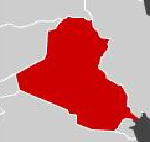 Iraq: Fewer public reports of seized shoulder-fired missiles in Iraq, but MANPADS still a threat
Iraq: Fewer public reports of seized shoulder-fired missiles in Iraq, but MANPADS still a threat
Publicly available reports of shoulder-fired, surface-to-air missiles discovered in insurgent arms caches in Iraq dropped off precipitously in 2009, but the reason for this decline is unclear. A survey of English-language media and US military sources yielded information on only a handful of illicit MANPADS recovered from arms caches in 2009, as opposed to dozens in previous years (See Missile Watch #3: Black Market Missiles Still Common in Iraq). Given the rigor of US and Iraqi efforts to recover illicit weapons and dismantle arms trafficking networks, it is possible that terrorists and insurgents did indeed have access to fewer missiles in 2009. It is also possible, however, that seized MANPADS simply are not being reported as frequently, possibly for security reasons. When queried about the apparent decrease, a representative from Multi-National Forces-Iraq declined to comment, saying only that “[f]or operational security, we are unable to provide such details…”[8]
Regardless of the reason for the decline in reported seizures, MANPADS remain a threat in Iraq, as evidenced by a recent incident in which a Chinook military helicopter was engaged by “multiple IR MANPADS.” The attack, which was first reported by Aviation Week’s David Fulghum, was reportedly thwarted by the helicopter’s anti-missile system.[9]
 Ireland: Alleged plot to shoot down a police helicopter may have involved surface-to-air missiles
Ireland: Alleged plot to shoot down a police helicopter may have involved surface-to-air missiles
In December, the Belfast Telegraph reported that “[d]issident republicans” had obtained an unspecified surface-to-air missile and were “…planning to use it to shoot down a helicopter full of police officers…” The article provides no additional details on the missile or the alleged plot, although an unidentified “police source” suggests that the “missile” may instead be a rocket-propelled grenade: “They [the dissidents] have access to rocket-propelled grenades or other surface-to-air missile [sic] and one of their priorities is to take out a helicopter.”[10] The Irish government and the Independent Monitoring Commission declined to comment on the story, and an email to the author of the Telegraph article went unanswered.
Too little information is available to assess the accuracy of the Telegraph’s claims. Yet even if Irish dissidents have access to a missile, a successful attack is far from guaranteed. Like many terrorist and insurgents worldwide, armed groups in Ireland have a long, largely unsuccessful history of illicit activity involving shoulder-fired missiles. Repeated attempts by the IRA to acquire Stinger missiles in the United States ended in jail time for many of the would-be missile traffickers,[11] and even when the group succeeded in procuring missiles with help of the Libyan government,[12] the IRA never effectively incorporated the missiles into its campaign against the British.[13] In the late 1990s, the group reportedly supplied some of its missiles to the Basque group ETA, who also failed to use them effectively (See below: “Spain: Alleged ETA member reveals details of failed attempts to assassinate Spanish prime minister”).
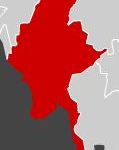 Myanmar: 300 shoulder-fired missiles in insurgent arsenal, claims Thai Colonel
Myanmar: 300 shoulder-fired missiles in insurgent arsenal, claims Thai Colonel
A Thai military official interviewed by the International Herald Tribune in November claimed that the United Wa State Army, a Burmese insurgent group, possesses 300 “shoulder-fired anti-aircraft missiles”[14] – a stockpile that is comparable in size to those of many small states. No additional details on the missiles were provided.
According to Jane’s Information Group, the Wa’s missile holdings consist of older SA-7s acquired in the early 1990s from “Cambodian black market sources,” and more sophisticated HN-5Ns from China.[15] These reports appear to be a decade old, however, so it is possible that the composition of the Wa’s current missile stockpile is very different.
If Colonel Peeranate’s estimate is accurate and the missiles are operational, the Wa’s missile stockpile is one of the largest non-state arsenals in the world. Little is known about the security of the Wa’s weapons, but the general lack of accountability and formal controls on insurgent arms caches and the size of the stockpile raises concerns about theft, loss and diversion, and the possibility that some of the missiles will end up on the black market.
 North Korea: North Korean arms shipment included man-portable air defense systems, Thai report confirms
North Korea: North Korean arms shipment included man-portable air defense systems, Thai report confirms
The Federation of American Scientists has learned that a cargo plane loaded with weapons from North Korea that was grounded in Bangkok in December contained man-portable air defense systems. According to a Thai report to the UN Security Council obtained by Bloomberg in January, the cargo contained “five crates of MANPADS SAM[s]”. The manufacturer, model and year of the MANPADS are not identified.[16] This information is required to fully assess the implications of the seizure, and to craft strategies for preventing similar shipments.
It is possible that the missiles were manufactured in North Korea, which has produced the Chinese HN-5 and the Soviet SA-14 and SA-16 under license,[17] and the Soviet SA-7 and US Stinger missile, which it reverse-engineered from missile technology acquired from Egypt in the 1970s and from the Afghan Mujahideen in the 1980s, respectively.[18] Another possibility is that the missiles were foreign-made and were transiting through, or were re-exported from, North Korea. This scenario could also have profound implications, depending on the origin and age of the missiles. Newly manufactured foreign missiles would suggest a recent government-to-government sale to North Korea – an egregious violation of the spirit if not the letter of international agreements on controlling MANPADS – or diversion from government stockpiles, which would likely be indicative of serious shortcomings in stockpile security policies and practices.
North Korea as a source of illicit MANPADS poses a significant challenge for policymakers since few if any of the diplomatic carrots and sticks used to secure MANPADS elsewhere would be effective vis-a-vis the Hermit Kingdom. Interdiction efforts associated with UN Security Council Resolution 1874 will likely make it more difficult to traffic in weaponry from North Korea, but shoulder-fired missiles are easy to smuggle, and adequately screening the contents of every plane and ship departing from North Korea would be impossible. The best that can reasonably be hoped for is that vigilance by North Korea’s neighbors and robust patrolling of international waters will limit North Korea’s arms smuggling in the near term, and that prioritization of the MANPADS proliferation threat by the six-party nations in negotiations with North Korean officials will yield a longer term solution.
The Thai report identifies Mahrabad Airport in Iran as the aircraft’s destination, although Thai officials have subsequently stated that Sri Lanka and the United Arab Emirates were also listed as stops in the flight documentation.[19] The Iranians have denied any involvement in the transfer, pointing out that they have no need for the shipment since Iran’s defense industry produces its own “modern weapons”.[20] But it is possible that the Iranians had ordered the weapons not for their own use but for their proxies in Lebanon or elsewhere. Foreign missiles would allow the Iranians to provide like-minded armed groups with much-needed air defense systems while maintaining plausible deniability regarding their role in the transfer. A similar strategy was pursued by the United States during the clandestine campaign to arm and train the Afghan Mujahideen during the Soviet occupation.[21] If the North Korean weapons were bound for Iran, they may have been intended for a similar purpose.
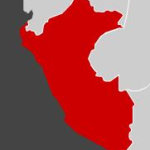 Peru: Igla missiles stolen from Peruvian Military, claims alleged trafficker
Peru: Igla missiles stolen from Peruvian Military, claims alleged trafficker
A self-proclaimed “logistics specialist” for Colombian rebels reportedly obtained seven Stela and Igla surface-to-air missiles from the arsenals of the Peruvian military according to the Miami Herald and the Lima-based La Republica newspaper. Ecuadorian national Freddy Torres allegedly acquired the missiles, along with other weapons, from a trafficking ring comprised of members of the Peruvian air force, army and police.[22] Four of the missiles were purchased between May and October 2008 and the remaining three were purchased in 2009, according to Juan Tamayo of the Miami Herald. Each of the missiles was reportedly purchased for “the sum of 45,000 US dollars.”[23]
Assuming man-portable Strela and Igla missiles were indeed stolen from Peruvian arsenals and sold to Colombian rebels, this case could have significant implications. The Revolutionary Armed Forces of Colombia (FARC) has tried unsuccessfully for years to acquire missiles capable of countering the Colombian armed forces growing fleet of fixed and rotary-wing aircraft, which are critical to its counter-insurgency operations. While a handful of Strela and Iglas will not turn the tide of the war in the FARC’s favor, the missiles could be very disruptive to Colombian air operations, at least in the short term.
Of greater consequence is the potential terrorist threat from the missiles. In the hands of a trained operator, a well-maintained missile poses a significant threat to civilian planes, including airliners; at least 45 civilian aircraft have been shot down by man-portable air defense systems worldwide since 1975.[24] The missiles are of significant value to the FARC’s war against the Colombian government and therefore the rebels are unlikely to use the missiles against commercial airliners. However, they could be used against high-value civilian targets such top government or military officials. The missiles could also be stolen or sold on the black market, where they would they could be acquired by terrorists with designs on an airliner.
The missile theft is also a critical test of the region’s commitment to combating the shoulder-fired missile threat. In 2005, the 35 members of the Organization of American States (OAS) adopted AG/RES.2145, a set of guidelines that urges member states to, inter alia, “…adopt and maintain strict national controls and security measures on Man-Portable Air Defense Systems and their essential equipment.” These guidelines include specific, rigorous stockpile security measures, such as separate storage of missiles and launchers, 24-hour surveillance, and strict controls on access to missiles.[25] The diversion of multiple missiles over a period of months raises serious questions about the Peruvian government’s implementation of these guidelines and the security of the rest of its missile stockpile, which numbers in the hundreds, according to Jane’s Information Group.[26] A robust response to this incident would show the region and the world that the OAS and its member states take the illicit trade in terrorist technology seriously and are willing to match rhetoric with action.
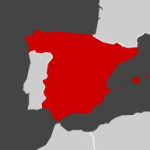 Spain: Failed assassination attempts underscore the risks for terrorists of relying on black market missiles
Spain: Failed assassination attempts underscore the risks for terrorists of relying on black market missiles
Intelligence obtained from an alleged member of the Basque terrorist group ETA revealed three failed attempts to shoot down the Spanish prime minister’s plane with a shoulder-fired, surface-to-air missile acquired from the Irish Republican Army in 1999. According to the Telegraph, the plots came to light after the arrest of the suspected ETA member, who reportedly told Spanish investigators that the group had tried three times in April and May 2001 to shoot down the plane but that the missile had malfunctioned each time. A letter addressed to the IRA discovered in the suspect’s home reportedly complains about defective missiles allegedly sold to ETA by IRA members based in Germany.[27] The missiles were seized from an ETA arms cache by French authorities in 2004.[28]
Media reports do not indicate whether authorities believe that the missiles used in the botched attack was indeed faulty or was used incorrectly. Contrary to popular belief, shoulder-fired missiles aren’t simply point-and-shoot weapons; they require training to use effectively, and it is not clear what training, if any, ETA members received in the operation of the missiles. Regardless of the reason for the failed attacks, this case underscores the risks for terrorists of relying on black market missiles, especially when the missiles are first generation technology that is nearing the end (or is past) its estimated shelf life and may have been tampered with or stored improperly. It is hoped that ETA’s bumbling – along with other spectacular failures like the unsuccessful missile attack on an Israeli airliner in Kenya in 2002 – will reduce black market demand for the most widely available (i.e. first generation) shoulder-fired missiles as terrorists recognize the folly of planning high-profile attacks around weapon systems that they do not fully understand and that may not function properly.
 United States: Congress to receive DHS report on anti-missile systems for commercial airliners in February
United States: Congress to receive DHS report on anti-missile systems for commercial airliners in February
The Federation of American Scientists has learned that a long-awaited report on the feasibility of installing anti-missile systems on commercial airliners is nearly finished, and will be delivered to Congress in February. “The report is nearing the end of review; we are still expecting a February delivery to Hill staff,” a DHS spokesperson confirmed in a correspondence with the Federation of American Scientists. The report, which will be sent to the House and Senate Appropriations Committees, summarizes the results of a program launched in 2003 to assess the “…viability, economic costs and effectiveness of adapting existing technology from military to commercial aviation use.” As noted in the last issue of Missile Watch, the response from Congress to the report will be a critical indicator of whether its early enthusiasm for outfitting commercial airliners with anti-missile systems – a multi-billion dollar undertaking – has survived DHS’ lengthy evaluation process and a constant barrage of competing agenda items.
United States: Documents from trial of the “Prince of Marbella” contain additional information on shoulder-fired missiles
Court documents recently obtained by the Federation of American Scientists provide some additional insight into the historic case of famed arms trafficker Monzer Al Kassar, but many important questions remain unanswered. In 2007, Kassar was arrested after allegedly agreeing to sell thousands of weapons, including shoulder-fired, surface-to-air missiles, to undercover informants posing as members of the Revolutionary Armed Forces of Colombia (FARC). A year later, Kassar was extradited to the United States and tried in New York, where he was convicted of, inter alia, conspiring to “acquire and export anti-aircraft missiles.”[29] The surprising arrest and conviction of Kassar brought an abrupt end to the career of one of the most prolific traffickers in recent history. According to the US government, clients of Kassar’s have included armed groups in Bosnia, Brazil, Croatia, Cyprus, Iraq, Iran, and Somalia, among others.[30]
Hundreds of court documents obtained by the Federation of American Scientists provide additional insight into the case, including Kassar’s offer to sell MANPADS to Colombian rebels. Summaries of phone conversations between Kassar and the DEA informants indicate that Kassar “…spoke about various types of surface-to-air missile systems– including SAM-7s, SAM-16s, and SAM-18s – and the systems’ respective abilities to destroy U.S. helicopters.” Previously released documents only reference the SA-7, a first generation Soviet-era missile that is easier to acquire and less capable than the SA-16 and SA-18. However, none of the documents reveal whether Kassar actually had access to the missiles, or – if he did – how many he had or where he acquired them. The Federation of American Scientists will continue to research these questions and report any additional findings in future issues of Missile Watch.
United States: No New International MANPADS Sales since 1999, says Raytheon
A spokesperson for the US defense firm Raytheon recently told the Federation of American Scientists that the U.S. government has not entered into new deals for Stinger MANPADS with foreign clients since 1999. In an email correspondence, Raytheon official Ty Blanchard told said that “[s]ince 1999, the U.S. government has denied requests from non-NATO countries asking for Stinger MANPADS. We have not had any requests from NATO countries in the last ten years.”[31]
This record of restraint illustrates the disparity in the policies of the major arms exporting states. Even as the US has curtailed international sales of man-portable Stingers, other countries have sold advanced systems to governments with dubious stockpile security and end-use controls.[32] Failure to align the policies of exporting countries could erode nascent global standards for MANPADS exports and undo much of the progress toward eliminating the terrorist missile threat achieved to date.
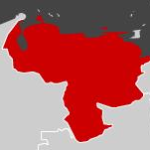 Venezuela: U.S. receives “assurances” from Russia regarding controls on shoulder-fired missiles sold to Venezuela, but key questions remain
Venezuela: U.S. receives “assurances” from Russia regarding controls on shoulder-fired missiles sold to Venezuela, but key questions remain
The Federation of American Scientists has learned that US officials have received “assurances” from the Russian government regarding end-use controls on SA-24 MANPADS sold to Venezuela, but detailed information on the nature and implementation of these controls remain scant. This information is critical to determining whether the SA-24s and the “thousands” of additional missiles[33] that Venezuelan President Hugo Chavez claims to be importing are in danger of being diverted to armed groups in the region or elsewhere.
In response to a query about the sale, a State Department spokeswoman told the Federation of American Scientists that U.S. officials “…have expressed our concerns to the Russian government on the control and security of arms transferred to Venezuela” and that they have “…received assurances from the Russian government that the deal conforms with end-use controls that meet international standards.”[34] The official did not indicate whether Russia has provided the US government with a list of specific controls, or the extent to which these controls have been implemented. The Russian and Venezuelan governments have yet to respond to requests from the Federation of American Scientists for additional information.
The most prominent set of ‘international standards’ on MANPADS controls are the Elements for Export Controls of MANPADS. Under the Elements, Russia has agreed to “…satisfy itself of the recipient government’s willingness and ability to implement effective measures for secure storage, handling, transportation, use of MANPADS material, and disposal or destruction of excess stocks to prevent unauthorised access and use.”[35] A more detailed set of procedures is laid out in an annex to the OSCE’s Best Practice Guide on National Procedures for Stockpile Management and Security of MANPADS, which the Russian government helped to draft. Minimally, the Russian government should ensure that Venezuela’s stockpile security and end-use policies and practices conform to the Wassenaar Arrangement’s Elements and the OSCE’s Best Practice Guide, and the Organization of American States’ Guidelines for Control and Security of MANPADS. Given the history of diversion from Venezuela’s arsenals,[36] regular on-site inventories and inspections by Russian officials are also merited. Failure to take these steps would raise serious questions about the Russian government’s commitment to implementing key international agreements and guidelines, including guidelines it helped to draft.
Additional News & Resources (11/ 2009- 1/2010)
- “Sarachandran jailed for 26 years for trying to aid Tamil Tigers,” National Post, 23 January 2010.
- “Helo-Protecting Advanced Sensors Hurried,” Aviation Week, 21 January 2010.
- “More Advanced SAMs Emerging in Combat Zones,” Aviation Week, 13 January 2010.
- “Missile defense: post DHS,” Avionics Intelligence, 7 January 2010.
- “R.O. CONGO: 750,000 dangerous items demolished in two years,” Mines Advisory Group, 11 December 2009.
- “Albanian Press Review – December 1,” Balkan Insight, 1 December 2009. The article includes a brief reference to an article in the Albanian newspaper Gazeta Tema about alleged transfers of MANPADS from Albania to Hezbollah. The full article is available on Gazeta Tema’s website, but it is in Albanian.
- “Cyprus Confronts Its MANPADS Menace,” OSCE Magazine,December 2009.
- “Powder Keg – Unfettered arms flows reflect Sudan’s instability,” Jane’s Intelligence Review, December 20009. The article includes a brief reference to the recent acquisition of SA-16 missiles by the SPLA.
- “Somali pirates seize Maran Centaurus oil tanker sailing from Saudi Arabia,” Times Online, 30 November 2009. The article includes a brief reference to reports of pirates using shoulder-fired, surface-to-air missiles. The report is probably in the Korea Times that the pirates had acquired Stinger missiles from al Qaeda. Missile Watch has been unable to substantiate these claims.
- “Arrests Made in Case Involving Conspiracy to Procure Weapons, Including Anti-Aircraft Missiles,” US Department of Justice, 23 November 2009.
- “Protecting Civil Aviation from MANPADS,” Bureau of Political-Military Affairs, 23 November 2009.
- “CSTO member nations coordinate positions on SALW and MANPADS”, Asia Plus, 20 November 2009.
Matt Schroeder is the Manager of the Arms Sales Monitoring Project at the Federation of American Scientists. Since joining FAS in February 2002, he has written more than 80 books, articles and other publications on US arms transfers, arms export policies, and the illicit arms trade. He is a co-author of the book The Small Arms Trade (Oxford: Oneworld Publications, 2007), and a consultant for the Geneva-based Small Arms Survey.
Matt Buongiorno is currently serving as a Scoville Fellow at the Federation of American Scientists where he is working on small arms issues, U.S. nuclear policy issues, and Iranian nuclear issues. In addition to his work with FAS, Matt is staffing the 2010 National Model United Nations, a conference in New York that draws over 4,000 students and aspiring diplomats. He earned a B.A. in economics and political science from Texas Christian University in 2009.
Missile Watch is a quarterly publication by the Arms Sales Monitoring Project at the Federation of American Scientists that tracks the illicit proliferation and use of man-portable air defense systems (MANPADS), and international efforts to combat the terrorist threat from shoulder-fired missiles.
To sign up for Missile Watch, go to /press/subscribe.html.
[1]David Fulghum, “Laser Saves Helo in Multi-SAM Ambush,” Aviationweek.com, 7 January 2010.
[2]“Yemen slams Shebab pledge to send fighters,” AFP, 2 January 2010.
[3]Correspondence with Major Steve Cole, spokesman for the IJC, 5 January 2010.
[4]DOD Should Apply Lessons Learned Concerning the Need for Security over Conventional Munitions Storage Sites to Future Operations Planning, Government Accountability Office, March 2007, p. 7.
[5]Colum Lynch, “U.N. Security Council orders arms embargo on Eritrea,” The Washington Post, 24 December 2009.
[6]Report of the Monitoring Group on Somalia, S/2007/436, 18 July 2007, p. 15.
[7]Report of the Monitoring Group on Somalia, S/2008/274, 24 April 2008, p. 24-25.
[8]Correspondence with MNF-Iraq, 19 November 2009. FOIA requests for similar information have also been denied. In January, US Central Command denied the release of six documents responsive to a Freedom of Information Act request filed by the FAS for information on “man-portable air defense systems collected or seized by Iraqi Security Forces or Coalition forces from 1 January 2007 to 1 June 2008.”
[9]David Fulghum, “Laser Saves Helo in Multi-SAM Ambush,” Aviationweek.com, 7 January 2010. While US Army officials did not identify the location of the attack, “…other military sources indicate it was in Iraq,” according to Fulghum.
[10]Deborah McAleese, “New Dissident Target…a Police Helicopter; Plan to Blast Lightly-armoured PSNI Chopper out of the Sky,” Belfast Telegraph, 2 December 2009.
[11]See Schroeder, Stohl and Smith, The Small Arms Trade (Oneworld Publications, 2007), p. 98-103.
[12]Smuggling efforts involving Libya were more fruitful. In the 1970s and 80s, the group acquired several MANPADS as part of a series of weapons shipments allegedly arranged by the Libyan government. But even these shipments were vulnerable to interdiction. The Eskund, for example, which reportedly contained 150 tons of weaponry, including 20 SA-7 missiles, was seized by French authorities in 1987.
[13]See Ian Bruce, “Why They’re Never Short of a Gun,” The Herald (Glasgow), 26 January 1998.
[14]“A Rebel Stronghold in Myanmar on Alert,” International Herald Tribune, 6 November 2009.
[15]“United Wa State Army (UWSA),” Jane’s World Insurgency and Terrorism, updated 11 November 2009 and Anthony Davis, “Myanmar heat turned up with SAMS from China,” Jane’s Defense Weekly, 28 March 2001.
[16]Some media reports identified the missiles as Chinese HN-5s, but these claims have not been corroborated.
[17]O’Halloran and Foss, Jane’s Land-based Air Defense 2008-2009 (Cambridge University Press, 2008), p. 22.
[18]O’Halloran and Foss, p. 22 and Schroeder, Stohl, Smith, The Small Arms Trade, p. 88.
[19]Daniel Ten Kate, “Thailand Urges UN Action on N. Korean Arms Cache as Cost Rises,” Bloomberg, 3 February 2010.
[20]“Seized Weapons Plane in Thailand not Heading for Iran: Official,” Tehran Times, 3 February 2010.
[21]The Central Intelligence Agency purchased weapons, including MANPADS, from Eastern European countries and China, refraining from sending more effective US Stinger missile until the final years of the campaign.
[22]Juan Tamayo, “Farc Rebels’ Missile Purchase Raises Concerns,” Miami Herald, 16 February 2010 and “Stolen Peruvian Arms Sold to Colombian Rebels,” EFE, 13 January 2010.
[23]Tamayo, “FARC Rebels’ Missile Purchase Raises Concerns”
[24]US Government data provided to the Federation of American Scientists, January 2010.
[25]Denying MANPADS to Terrorists: Control and Security of MAN-Portable Air Defense Systems, Adopted 7 June 2005, available at /asmp/campaigns/MANPADS/2005/OASmanpads.pdf.
[26]See “Peru,” Jane’s World Armies, posted 8 January 2010.
[27]Fiona Govan, “Spanish PM saved from assassination by faulty IRA missile,” Telegraph, 18 January 2010.
[28]“French police find anti-aircraft missiles in ETA cache,” Associated Press Worldstream, 5 October 2004.
[29]“International Arms Trafficker Monzer al Kassar and Associate Sentenced on Terrorism Charges,” US Attorney’s Office, Southern District of New York, 24 February 2009.
[30]United States of America –v. – Mozer Al Kassar, a/k/a “Abu Munawar,” a/k/a “El Taous,” Tareq Mousa al Gahzi, and Luis Felipe Moreno Godoy, June 2007, p. 1.
[31]Correspondence with Ty Blanchard, Raytheon’s business development manager for army advanced programmes, 2 February 2010.
[32]See, for example, Andrei Chang, “China ships more advanced weapons to Sudan,” UPI Asia, 28 March 2008.
[33]“Chavez: Venezuela acquires thousands of missiles,” Associated Press, 7 December 2009. According to the Associated Press, Chavez claimed in early December 2009 that “[t]housands of missiles…”and rocket launchers, reportedly Russian-made, “…are arriving” in Venezuela, although he did not identify the type of missiles and rockets.
[34]Correspondence with State Department officials, 12 January 2010. The full response from the State Department reads as follows: “Russia is a major supplier of arms to Venezuela. We have expressed our concerns to the Russian government on the control and security of arms transferred to Venezuela. We have received assurances from the Government of Russia that the deal conforms with end-use controls that meet international standards. Particularly given reports of Venezuelan-origin [weapons] surfacing in neighboring countries, we urge the Government of Venezuela to implement strict controls to prevent the diversion of arms and ammunition.”
[35]These measures include monthly physical inventories of all imported missiles and launchers, storage of missiles and launchers in separate locations, continuous (24-hour) surveillance, and limiting storage site access to two people with proper security clearances, among others.
[36]For a partial list of recent reports, see footnote 5 in “Securing Venezuela’s Arsenals,” FAS Strategic Security Blog, 24 August 2009.
North Korea: FAS Says We Have Nukes!
 |
By Hans M. Kristensen
North Korea’s news agency – Korean Central News Agency – apparently has issued a statement saying that “The Federation of American Scientists of the United States has confirmed (North) Korea as a nuclear weapon state.” According to a report in the Korea Herald, the statement said a FAS publication issued in November listed North Korea as among the nine countries that possess nuclear weapons.
It’s certainly curious that they would need our reaffirmation, but after two nuclear tests we feel it is safe to call North Korea a nuclear weapon state. However, the agency left out that our assessment comes with a huge caveat:
“We are not aware of credible information on how North Korea has weaponized its nuclear weapons capability, much less where those weapons are stored. We also take note that a recent U.S. Air Force intelligence report did not list any of North Korea’s ballistic missiles as nuclear-capable.”
In other words, two experimental nuclear test explosions don’t make a nuclear arsenal. That requires deliverable nuclear weapons, which we haven’t seen any signs of yet. Perhaps the next statement could explain what capability North Korea actually has to deliver nuclear weapons.
This publication was made possible by a grant from Carnegie Corporation of New York and Ploughshares Fund. The statements made and views expressed are solely the responsibility of the author.
Estimated Nuclear Weapons Locations 2009
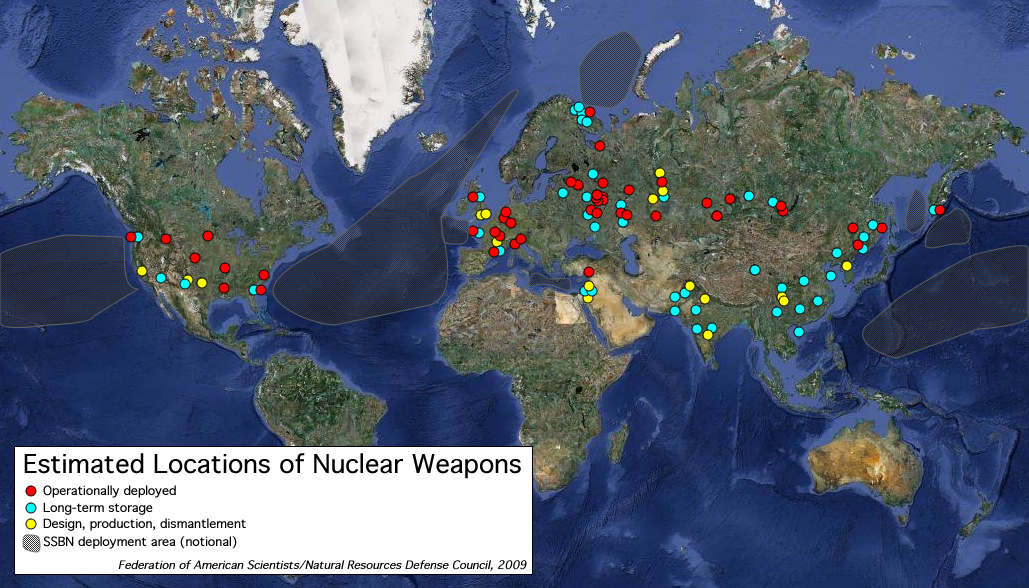
Some 23,300 nuclear weapons are stored at 111 locations around the world
.The world’s approximately 23,300 nuclear weapons are stored at an estimated 111 locations in 14 countries, according to an overview produced by FAS and NRDC.
Nearly half of the weapons are operationally deployed with delivery systems capable of launching on short notice.
The overview is published in the Bulletin of the Atomic Scientists and includes the July 2009 START memorandum of understanding data. A previous version was included in the annual report from the International Panel of Fissile Materials published last month.
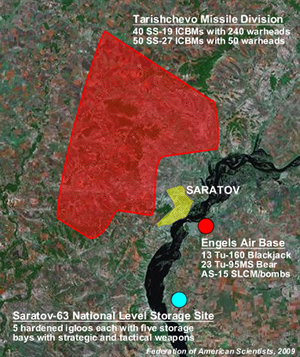
More than 1,000 nuclear weapons surround Saratov.
Russia has an estimated 48 permanent nuclear weapon storage sites, of which more than half are on bases for operational forces. There are approximately 19 storage sites, of which about half are national-level storage facilities. In addition, a significant number of temporary storage sites occasionally store nuclear weapons in transit between facilities.
This is a significant consolidation from the estimated 90 Russian sites ten years ago, and more than 500 sites before 1991.
Many of the Russian sites are in close proximity to each other and large populated areas. One example is the Saratov area where the city is surrounded by a missile division, a strategic bomber base, and a national-level storage site with probably well over 1,000 nuclear warheads combined (Figure 2).
The United States stores its nuclear weapons at 21 locations in 13 states and five European countries. This is a consolidation from the estimated 24 sites ten year ago, 50 at the end of the Cold War, and 164 in 1985 (see Figure 3).
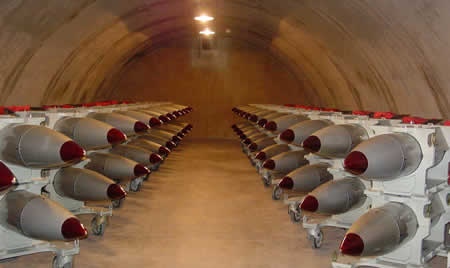
Approximately 50 B61 nuclear bombs inside an igloo at what might be Nellis Air Force Base in Nevada. Seventy-five igloos at Nellis store “one of the largest stockpile in the free world,” according to the U.S. Air Force, one of four central storage sites in the United States.
Europe has about the same number of nuclear weapon storage locations as the Continental United States, with weapons scattered across seven countries. This includes seven sites in France and four in Britain. Five non-nuclear NATO countries (Belgium, Germany, Italy, the Netherlands, and Turkey) still host U.S. nuclear weapons first deployed there during the Cold War.
We estimate that China has 8-14 facilities associated with nuclear weapons, most likely closer to the lower number, near bases with units that operate nuclear missiles or aircraft. None of the weapons are believed to be fully operational but stored separate from delivery vehicles at sites controlled by the Central Military Commission.
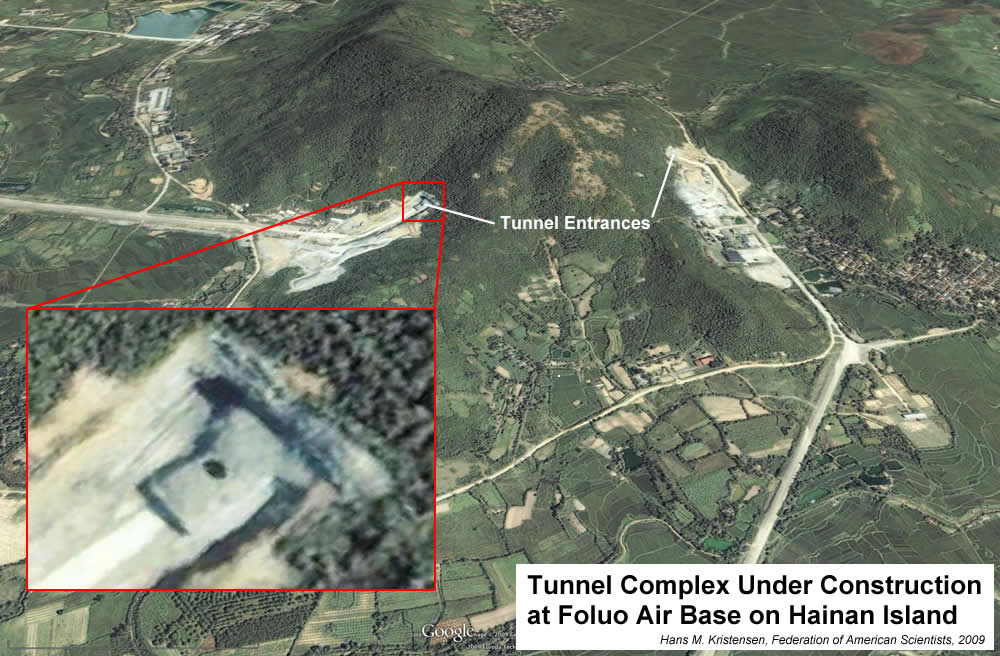
Where does China store nuclear warheads for its ballistic missile submarines? The naval base near Julin on Hainan Island has extensive underground facilities. An alternative to the base itself could potentially be a facility elsewhere on the island, such as Foluo Air Base where construction of an underground facility began five years before the first SSBN arrived at Hainan. Or are the weapons stored on the mainland? Click image to enlarge.
Israel probably has about four nuclear sites, whereas the nuclear storage facilities in India and Pakistan are – despite many rumors – largely undetermined. All three countries are thought to store warheads separate from delivery vehicles.
Despite two nuclear tests and many rumors, we are unaware of publicly available evidence that North Korea has operationalized its nuclear weapons capability.
Warhead concentrations vary greatly from country to country. With 13,000 warheads at 48 sites, Russian stores an average of 270 warheads at each location. The U.S. concentration is much higher with an average of 450 warheads at each location. These are averages, however, and in reality the distribution is thought to be much more uneven with some sites only storing tens of warheads.
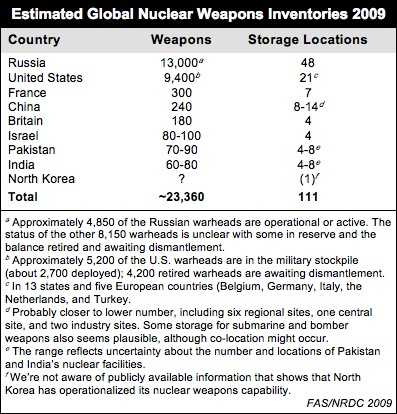
Finally, a word of caution is in order: estimates such as these obviously come with a great deal of uncertainty, as we don’t have access to classified intelligence estimates. Based on publicly available information and our own assumptions we have nonetheless produced a best estimate that we hope will assist the public debate. Comments and suggestions are encouraged so we can adjust the overview in the future.
This publication was made possible by a grant from Carnegie Corporation of New York and Ploughshares Fund. The statements made and views expressed are solely the responsibility of the author.
No U.S. Nukes in South Korea
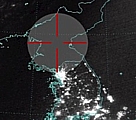 |
|
North Korea mistakenly believes there are U.S. nuclear weapons in South Korea. |
By Hans M. Kristensen
The North Korean newspaper Rodong Sinmun reportedly has issued a statement saying the U.S. has 1,000 nuclear weapons in South Korea. In this regional war of rhetoric it is important to at least get one fact right: The United States does not have nuclear weapons in South Korea. It used to – at some point close to 1,000 – but the last were withdrawn in 1991.
The only nuclear weapons the United States has in the Pacific today are the hundreds of warheads deployed on Trident II D5 sea-launched ballistic missiles on board eight Ohio-class nuclear-powered submarines patrolling in the Pacific Ocean. Some of them may be earmarked for potential use against targets in North Korea. Other weapons for bombers could be moved into the region if necessary, but they’re not today.
The North Korean obsession with the U.S. nuclear “threat” might be seen as confirmation that the nuclear deterrent works and hopefully will deter North Korea from attacking anyone. But the flip side of the coin is to what extent the U.S. nuclear posture in the Pacific – past and present – helps feed the North Korean nuclear rhetoric and perhaps even ambitions.
Additional information: A history of U.S. nuclear weapons deployment to and withdrawal from South Korea.
North Korea’s Nuclear Test: Another Fizzle?
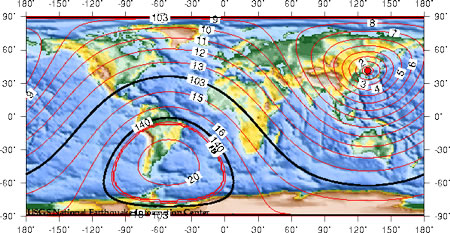 |
| The North Korean nuclear test on May 25, 2009, was “heard” loud and clear around the world despite its apparent limited size. Detection of small, clandestine nuclear tests seems to work. |
.
By Hans M. Kristensen
The Korean Central News Agency reportedly has announced that North Korea “successfully conducted one more underground nuclear test on May 25 as part of measures to bolster its nuclear deterrent for self-defense.” Several news media reported that the Russian Ministry of Defense estimating the test had a yield of approximately 10 to 20 kilotons.
Yet the preliminary seismic data published by the U.S. Geological Survey (USGS) shows that the test had a seismic magnitude of 4.7, only slightly more powerful than the 4.3 of the 2006 test.
Was it another fizzle? We’ll have to wait for more analysis of the seismic data, but so far the early news media reports about a “Hiroshima-size” nuclear explosion seem to be overblown.
Update: CTBTO’s initial findings.
.
North Korea Launches Rocket but Satellite Fails
Despite a world of advice to the contrary, the North Koreans launched their Taepodong-2 or Unha rocket yesterday morning. Recent reports are that the first two stages operated correctly but the third stage failed. Reading between the lines a bit, it might have failed to ignite rather than exploding. This seems to be a replay of the Taepodong-1 test satellite launch attempt: In that case, both stages one and two seemed to operate properly but the third stage apparently exploded and the satellite never entered orbit. (That failure did not discourage the North Koreans, who announced that the whole thing was a great success and the satellite was up there. My bet is they will do the same thing this time.)
So was the test a failure? Not at all. The reason the world is worried about this test is not because we are worried about competition in the satellite launch business. (Good luck to them!) The world worries because the launcher the North Koreans used is a Taepodong-2, which most everyone believes is their next step up toward a long-range ballistic missile. By taking a warhead off and putting a small third stage and a satellite on top, they might call it a space launcher but the first two stages are exactly the same. The last time the configuration was tested, it exploded 40 seconds into its flight and that flight was a clear failure. No doubt, the North Koreans would have been happier this time with a little satellite up there broadcasting patriotic songs but everything they needed to test for a military missile appears to have worked in yesterday’s test. From the military perspective, the test at this point seems to have been largely successful, in that it demonstrated what needed to be demonstrated and the North Koreans got the information they needed to get.
Does this mean they have a missile that can reach the United States? Well, not really. This test is a big step forward for them but one test does not make a ballistic missile program. There is much more for them to do. We have no idea what they judge the accuracy of the missile and they have not tested an appropriate reentry vehicle. This missile test is an very unfortunate development. I wish the North Koreans had more finese. But it does not give them a ballistic missile capability yet.
Addendum: More information is coming it. Apparently, not only did the satellite fail to enter orbit, but the second stage fell short of the predicted impact area. That suggests that the second stage failed. It could even be that the third stage operated successfully–separated, ignited, guidance worked, and so forth–but without the proper speed and altitude provided by the second stage, it would have no chance of making orbit. If this turns out to be the case, then the conclusions above have to be modified and this is a more limited step forward for the North Korean Taepodong-2 program.
